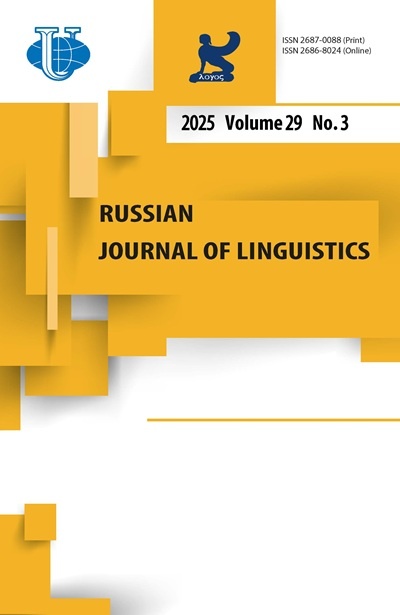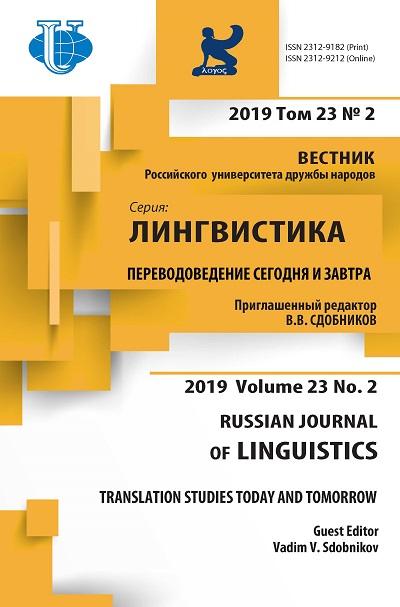Vol 23, No 2 (2019): Translation studies today and tomorrow
- Year: 2019
- Articles: 20
- URL: https://journals.rudn.ru/linguistics/issue/view/1192
- DOI: https://doi.org/10.22363/2312-9182-2019-23-2
Full Issue
TRANSLATION STUDIES TODAY AND TOMORROW
Translation Studies Today: Old Problems and New Challenges
Abstract
 295-327
295-327


Paving the way to the text: Forms and Functions of Book Titles in Translation
Abstract
 328-343
328-343


Impact of technology on Translation and Translation Studies
Abstract
 344-361
344-361


Intertextuality as Translation Problem: Explicitness, Recognisability and the Case of “Literatures of Smaller Nations”
Abstract
 362-382
362-382


Translating Ideology: An Intergroup Mediation Perspective
Abstract
 383-398
383-398


“A Sensible Image of the Infinite”: Intersemiotic Translation of Russian Classics for Foreign Audiences
Abstract
 399-414
399-414


Magic Folk Tales in Intersemiotic Translation
Abstract
 415-434
415-434


Linguocultural Localization of Movie Titles
Abstract
 435-459
435-459


The Deformation of Language in James Joyce’s Literary Works: Interpretation and Translation Challenges
Abstract
 460-472
460-472


Translation of Words with a Cultural Component (Based on the Spanish Translation of the Novel by Eugene Vodolazkin “The Aviator”)
Abstract
 473-486
473-486


Cultural Words in Sacral Text and their Translation: Linguistic and Extra-Linguistic Factors
Abstract
 487-508
487-508


Mode in Arabic-English Translation: with Reference to the Quran
Abstract
A rhetorical question has the form of a question but does not perform its function, i.e. does not seek any information but rather, is used to give a specific or rhetoric function such as denial, assertion, testing, equalization and negation. The present study investigates the two English translations that were used in the translation of the Quranic rhetorical questions. In a nutshell, this is a comparative study that aims to discover if the grammatical shifts that had occurred in the two English translations would have an effect on the denial, assertion, testing, and equalization and negation modes of the Quranic rhetorical questions. For this purpose, we had adopted the register theory of Halliday and Hassan (1985) as well as the translation shifts of Catford (1965) in the comparison of the two English translations, namely the Koran Interpreted that was authored by Arberry (1955) and the Noble Quran: English translation of the meanings and commentary as transcribed by al-Hilali and Khan (1996). According to the analyses, the occurrence of grammatical shifts between the two translations had in fact affected the mode of the ST rhetorical questions, their rhetorical meanings and consequently, issues on mode sustenance. Therefore, it can be said that the register theory of Halliday and Hassan (1985) had been a beneficial tool used in the analysis of the translation process.
 509-522
509-522


Gender-Neutral Linguistic Transformations of Messianic Scriptures in the Modern Anglican Homiletic Literature
Abstract
 523-543
523-543


Working on Сomputer-Assisted Translation platforms: New advantages and new mistakes
Abstract
 544-561
544-561


BOOK REVIEWS
New Trends in Modern Translation Studies Review of Mishkurov E.N., 2018. “Hermeneutics of Translation” (Theoretical and Methodological Standard). Moscow, 299 p
Abstract
 562-568
562-568


Review of Shlepnyev D.N., 2019. General Theory of Translation: Beginnings. Job Introduction Part II. Nizhny Novgorod: NGLU, 354 p
 569-574
569-574


INTERVIEWS WITH TRANSLATORS AND INTERPRETERS
INTERVIEWS WITH TRANSLATORS AND INTERPRETERS
 575-580
575-580


INTERVIEWS WITH TRANSLATORS AND INTERPRETERS
 581-583
581-583


INTERVIEWS WITH TRANSLATORS AND INTERPRETERS
 584-590
584-590


INTERV'Yu S PEREVODChIKAMI
 591-594
591-594
















